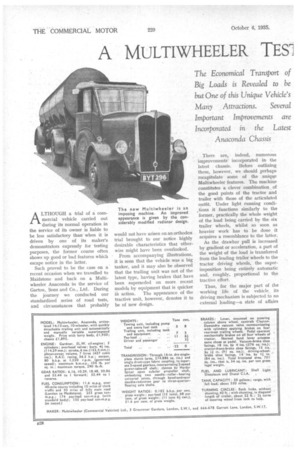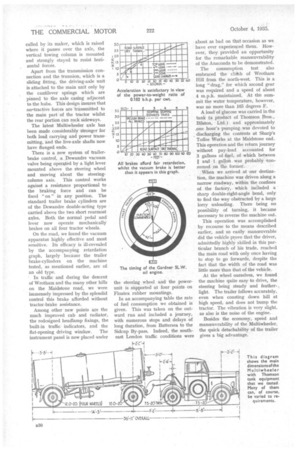A MULTI WHEELER TEK ED ON ACTUAL SERVICE
Page 42

Page 43

Page 44

If you've noticed an error in this article please click here to report it so we can fix it.
ALTHOUGH a trial of a commercial vehicle carried out during its normal operation in the Service of its owner is liable to be less satisfactory than when it is driven by one of its maker's demonstrators expressly for testing purposes, the former course often shows up good or bad features which escape notice in the latter.
Such proved to be the case on a recent occasion when we travelled to Maidstone and back on a Multiwheeler Anaconda in the service of Garton, Sons and Co., Ltd. During the journey we conducted our standardized series of road tests, and circumstances that probably would not have arisen on an orthodox trial brought to our notice highly desirable characteristics that otherwise might have been overlooked.
From accompanying illustrations, it is seen that the vehicle was a big tanker, and it may also be observed that the trailing unit was not of the latest type, having brakes that have been superseded on more recent models by equipment that is quicker in action. The appearance of the tractive unit, however, denotes it to be of new design.
There are„ indeed, numerous improvements incorporated in' the latest chassis. Before outlining them, however, we should perhaps recapitulate some of the unique Multiwheeler features. The machine constitutes a clever combination., of the good points of the tractor and trailer with those of the articulated outfit. Under light running conditions it functions similarly to the former, practically the whole weight of the load being carried by the six trailer wheels, whilst so soon as heavier work has -to be done it acquires a resemblance to the latter.
As the drawbar pull is increased by gradient or acceleration, a part of the weight of the load is transferred from the leading trailer wheels to the tractor driving wheels, the superimposition being entirely automatic and, roughly, proportional to the tractive effort.
Thus, for the major part of the working life of the vehicle its driving mechanism is subjected to no external loading—a state of affairs
that is regarded by engineers as desirable—whilst, in circumstances likely to induce wheelslip, the downward pressure on the rear of the tractive-unit is increased.
The mechanism effecting this weight transference is quite simple. The spring-loaded drawbar, which is constructed to resist bending stresses, is free to move axially in a trunnion. mounted guide at its rear end, but its motion is controlled by a pair of links at the front of the turntable, shown in the dimension sketch. As the bar is pulled forward, the links compel downward movement of its front end with the desired result.
In addition, provision is made for manually altering the position of the drawbar front attachment on the towing pillar, so that the weight superimposition is independently adjustable. It .is actually possible, by this means, to lift the leading trailer wheels practically clear of the ground. This is of the greatest value when reversing, for by also locking the turntable in its normal position the outfit becomes, in effect, a three-axle articulated machine.
This brings us to a consideration of the legal definition of the Multiwheeler. Originally these outfits were licensed as tractors and ,trailers. In this connection it is interesting to recall that there are Multiwheelers still in service which are 14 years old. About the time of the Salter Report, hoWever, the classification was revised, and they are now regarded as articulated vehicles.
The position appears to be as follows, and there seems justification for holding the opinion that an ambiguity in the wording of certain regulations has been interpreted in a not wholly fair manner in determining the Multiwheeler's category.
Except when this hand-operated screw-gear is used, no load is super
imposed, other than the equivalent of ballast necessary for propulsion. Thus these machines would appear to be tractors and trailers. Section 14 of the Finance Act, 1922, however, states, in effect, that if at any time a vehicle be used in an altered form, which would bring it into another class with a higher rate of duty, the last named shall apply.
Thus a device, employed solely for rendering the vehicle reversible and brought into service only occasionally and never while the machine is normally travelling, subjects it to a handicap in respect of taxation.
There is one more mechanical feature of the drawbar to be mentioned. A highly important advantage that its longitudinal movement affords is that when the tractor is in the act of getting a heavily laden trailer under way from a difficult position—for example, up a hill or with sunken wheels—it can, in doing so, move an appreciable distance before motion of the trailer begins.
We have discussed, up to now, principles of the design that have been in eXistence for a long time. There is also a number of new features. Most important of these is the method now adopted of building the rear portion of the tractor as a separate unit from the remainder.
The main frame ends just behind the cab and carries a pair of cantilever springs projecting rearwards. The rear portion comprises a short, sturdy frame terminating at the front in a fitting, which enters a trunnionmounted socket at about the centre of the tractor chassis, and supported by semi-elliptic springs on the driving axle. Upon this torque frame, as it is called by its maker, which is raised where it passes over the axle, the vertical towing column is mounted and strongly stayed to resist horizontal forces.
Apart from the transmission connection and the trunnion, which is a sliding fitting, the driving-axle unit is attached to the main unit only by the cantilever springs which are pinned to the axle casing adjacent to the hubs. This design insures that nwtractive forces are transmitted to the main part of the tractor whilst the rear portion can rock sideways.
The latest Multiwheeler axle has been made considerably stronger for both load carrying and power transmitting, and the live-axle shafts now have flanged ends.
There is a new system of trailerbrake control, a Dewandre vacuum valve being operated by a light lever mounted above the steering wheel and moving about the steeringcolumn axis. This control works against a resistance proportional to the braking force and can be fixed " on " in any position. The standard trailer brake cylinders are of the Dewandre double-acting type carried above the two short rearmost axles. Both the normal pedal and lever now operate mechanically brakes on all four tractor wheels.
On the road, we found the vacuum apparatus highly effective and most sensitive. Its efficacy is ill-revealed by the accompanying retardation graph, largely because the trailer brake-cylinders on the machine tested, as mentioned earlier, are of. an old type.
In traffic and during the descent of Wrotham and the many other hills on the Maidstone road, we were immensely impressed by the splendid control this brake afforded without tractor-brake assistance.
Among other new points are the much improved cab and radiator, the redesigned headlamp fixings, the built-in traffic indicators, and the flat-opening driving window, The instrument panel is now placed under the steering wheel and the powerunit is supported at four points on Floatex rubber mountings.
In an accompanying table the rate of fuel consumption we obtained is given. This was taken on the outward run and included a journey, with numerous stops and delays of long duration, from Battersea to the Sidcup By-pass. Indeed, the southeast London traffic conditions were about as bad on that occasion as we have ever experienced them. However, they provided an opportunity for the remarkable manceuvrability of the Anaconda to be demonstrated.
The consumption test also embraced the clifkb of Wrotham Hill from the north-west. This is a long "drag," for which second gear was required and a speed of about 4 m.p.h. maintained. At tife summit the water temperature, however, was no more than 165 degrees F.
A load of glucose was carried in the tank (a product of Thomson Bros., Bilston, Ltd.) and approximately ,one hour's pumping was devoted to , discharging the contents at Sharp's Toffee Works at the Maidstone end. This operation and the return journey without pay-load accounted for 3 gallons of fuel, of which between an4 1 gallon was probably consumed on the former.
When we arrived at our destination, the machine was driven along a narrow roadway, within the confines of the factory, which included a sharp double-right-angle bend, only to find the way obstructed by a large lorry unloading. There being no possibility of turning, it became necessary to reverse the machine out.
This operation was accomplished by recourse to the means described earlier, and so easily manceuvrable did the vehicle prove that the driver, admittedly highly skilled in this particular branch of his trade, reached the main road with only once having to stop to go forwards, despite the fact that the width of the road was little more than that of the vehicle.
At the wheel ourselves, we found the machine quite easy to drive, the steering being steady and featherfight. The trailer follows accurately, even when coasting down hill at high speed, and does not bump the tractor. The vibration is very slight, as also is the noise of the engine.
Besides the economy, speed and manceuvrability of the Multiwheeler, the quick detachability of the trailer gives a big advantage.




























































































